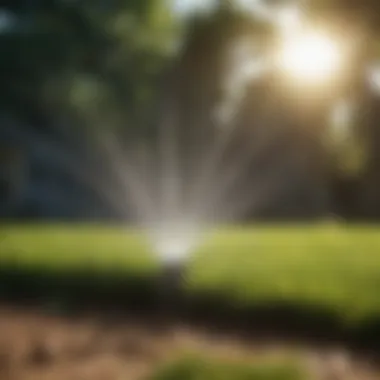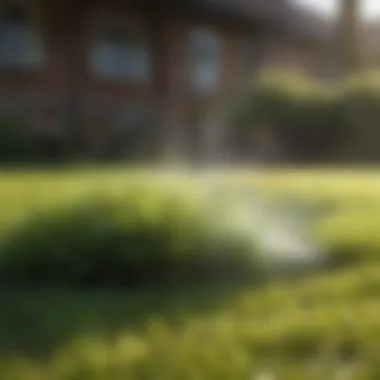Best Practices for Lawn Watering: A Comprehensive Guide


Intro
Watering a lawn is a critical aspect of maintaining its health and aesthetic appeal. Understanding the right techniques can sometimes be overwhelming for homeowners, farmers, and gardening enthusiasts alike. This article seeks to clarify these techniques, focusing on the optimal volume and frequency of watering. By dissecting the various elements involved, the goal is to identify effective strategies that promote sustainability while ensuring a lush, green surface.
Overview of the Topic
Definition and Importance
Lawn watering practices pertain to how much water is applied to turfgrass and how often this application occurs. Ensuring that grass receives adequate moisture is vital for its growth, health, and resilience against drought. Proper watering not only supports grass development but also plays a role in preventing diseases and minimizing pests. Moreover, efficient watering practices can significantly conserve water, which is crucial in regions facing drought or water shortages.
Current Trends
Recent studies highlight the need for more efficient irrigation systems. Smart irrigation technologies that adjust water usage based on weather conditions are gaining traction. Additionally, using drought-resistant grass varieties is becoming popular among environmentally conscious homeowners. These approaches aim to lessen water wastage while optimizing lawn care.
Key Techniques and Practices
Step-by-Step Guide
- Understand your soil type. Different soils have varied water retention abilities. Sandy soils drain quickly while clay soils retain moisture longer.
- Measure lawn area. Knowing the size of the lawn helps in calculating the amount of water needed.
- Determine watering frequency. Most lawns require about 1 to 1.5 inches of water weekly, either from rainfall or irrigation.
- Water in the early morning. This prevents evaporation and encourages deeper root growth.
- Monitor lawn health. Adjust watering based on changing weather conditions and signs of stress in the grass.
Tools and Equipment Needed
- Sprinklers and hoses: Essential for effective watering. A sprinkler system can be automated for convenience.
- Soil moisture sensors: These devices help determine when the grass needs watering.
- Rain gauges: Useful for measuring natural rain and adjusting irrigation accordingly.
Challenges and Solutions
Common Obstacles
One challenge many face is overwatering, which can lead to shallow roots and increased vulnerability to diseases. Additionally, underwatering is problematic as it stresses the turf, leading to brown patches.
Innovative Solutions
To mitigate these issues, utilizing smart irrigation systems becomes vital. These systems analyze weather data and soil moisture to automate watering. Also, practicing deep watering techniques helps soil absorb moisture more effectively.
"Proper lawn watering practices are essential for a healthy and sustainable yard, balancing both grass wellness and resource conservation."
By understanding the myriad factors that influence optimal lawn watering practices, individuals can cultivate not only beautiful landscapes but also contribute to sustainable water management.
Importance of Lawn Irrigation
Lawn irrigation plays a critical role in maintaining a healthy and vibrant lawn. It is not merely about providing water; it is about ensuring that the right amount of water reaches the roots of grass and other plants. The importance of lawn irrigation extends to various facets of lawn care, ranging from aesthetic appeal to environmental impact. For homeowners, a well-watered lawn is often a source of pride. It enhances the property’s curb appeal and can even increase property value.
Moreover, proper lawn irrigation fosters robust growth and better resilience against pests and diseases. Grass that receives adequate water is denser and greener. This natural defense mechanism means fewer chemicals may be necessary to maintain health. Additionally, efficient watering practices conserve water resources, promoting sustainability. This responsible approach to lawn care aligns with larger environmental considerations, such as reducing water waste and optimizing water resources amidst increasing global scarcity.
Benefits of Proper Watering
Proper watering practices yield numerous benefits:
- Healthier Grass: Consistent watering leads to deeper root systems, allowing the grass to both better absorb nutrients and withstand stress.
- Weed Control: A well-watered lawn grows faster and can outcompete weeds, reducing the need for herbicides.
- Aesthetic Appeal: A lush green lawn is visually pleasing and improves neighborhood aesthetics.
- Soil Health: Improved water management helps maintain soil structure and nutrient availability.
The cumulative effect of these benefits can manifest significantly in the appearance and health of the lawn, creating a more sustainable and pleasant outdoor space.
Consequences of Inadequate Watering
Inadequate watering can lead to several adverse effects that can ruin lawn health and appearance. Some notable consequences include:
- Drought Stress: Grass deprived of water will wilt and turn brown, signaling distress.
- Sparse Growth: Insufficient irrigation can cause uneven patches and bald spots in the lawn.
- Pest Infestation: Weak grass is more prone to pest issues, leading to potential damage and increased management needs.
- Limited Nutrient Uptake: Without adequate moisture, grass cannot absorb essential nutrients, leading to poor overall health.


Understanding Lawn Water Needs
Understanding lawn water needs is crucial for developing effective irrigation strategies. Proper knowledge helps maintain a healthy lawn and reduces water waste. When homeowners know what their lawn requires, they can make informed decisions on the volume and frequency of watering. This knowledge prevents issues like overwatering or underwatering, both of which can harm the lawn's health. It sets the stage for sustainability and efficiency in lawn care.
Factors Influencing Water Requirements
Grass species
Grass species play a significant role in water needs. Different types of grass have varying tolerances to drought and different patterns of root growth. For example, Kentucky Bluegrass is popular for its lush appearance but demands more water compared to Bermudagrass, which is more drought-resistant. In arid regions, selecting drought-tolerant species is crucial. The unique feature of grass species lies in their adaptability to local conditions, which impacts their water usage.
Soil type
Soil type contributes significantly to water retention and drainage properties. Sandy soil, for example, drains quickly and requires more frequent watering. On the other hand, clay soil retains moisture well but may lead to waterlogging if overwatered. Loamy soil, a combination of sand, silt, and clay, is generally the best option for lawns, balancing water retention and drainage. Understanding soil characteristics aids in determining the right watering practices for lawn health.
Climate conditions
Climate conditions affect how much water a lawn needs. Hotter climates with longer dry spells increase the need for watering, while cooler regions may require less frequent irrigation. In addition, humidity can impact evaporation rates. In humid areas, lawns may retain moisture for longer periods. Recognizing your local climate is essential in scheduling and adjusting watering plans.
Seasonal changes
Seasonal changes also affect watering demands. During spring, growth rates increase, necessitating more frequent watering. In contrast, during winter, many grasses go dormant and need less water. Homeowners should adjust their watering practices according to the season. This adaptability ensures that the lawn receives adequate moisture without excess, promoting a healthy growing environment.
Watering Requirements by Region
Regional differences dictate distinct watering requirements. Factors such as temperature, precipitation, and local climate all influence how much water various lawns need. For example, lawns in the southwest might require larger volumes due to fewer rainfall events, while regions with abundant rainfall such as the Midwest may rely on natural precipitation. This context helps guide users in aligning their watering schedules with local weather patterns.
Understanding your lawn’s water needs is the first step toward establishing an efficient irrigation system. It matters from the choice of grass species to how much you water it each week.
Frequency of Watering
The frequency of watering a lawn is crucial for its health and vitality. This element can significantly impact the overall appearance and growth of grass. Understanding how often to water can prevent both under-watering and over-watering, which can lead to various lawn problems. Proper frequency ensures that the grass develops a robust root system, which is essential for survival during dry spells.
Farmers and lawn care enthusiasts should be aware of the balance required in this practice. A well-thought-out watering schedule can enhance water efficiency and promote sustainable horticultural practices. The benefits of determining the correct frequency of watering include:
- Water Conservation: Efficient watering reduces unnecessary water use.
- Healthy Grass Growth: Regular watering encourages deeper root systems.
- Prevention of Pests and Diseases: A properly watered lawn is less prone to diseases.
Daily vs. Weekly Watering
When considering how often to water, homeowners face a choice between daily and weekly schedules. Daily watering may seem beneficial, but it can be counterproductive. Frequent light watering encourages shallow roots, making the lawn dependent on this routine. In contrast, watering once or twice a week allows the grass to absorb moisture deeper into the soil. This leads to stronger roots.
For general recommendations:
- Water early in the morning to reduce evaporation.
- Aim for about 1-1.5 inches of water per week, including rainfall.
Signs of Underwatering
Underwatering can manifest in various ways. Awareness of these signs is essential for prompt corrective measures. Most common indicators include:
- Wilting Grass: The blades of grass may begin to fold or wilt.
- Color Changes: Grass can turn from vibrant green to a dull or brown hue.
- Footprints Visible: If footprints remain visible after walking on grass, it may need water.
Paying attention to these symptoms is vital. Healthy lawns require consistent moisture to thrive. Adjusting watering practices based on observed conditions can minimize stress on the grass.
Signs of Overwatering
While the lack of water is detrimental, too much water can be equally harmful. Overwatering presents distinct signs that must not be ignored. Common symptoms include:
- Pooling Water: Water that collects in certain areas of the lawn can indicate overwatering.
- Fungal Growth: If fungi appear, it often means that water sits on the grass for too long.
- Yellowing Grass: Grass may yellow or start dying off, particularly at the roots.
Identifying these problems early allows for adjustments. A careful balance must be maintained.


Remember, maintaining optimal watering practices is key to preventing lawn issues and ensuring a sustainable approach to lawn care.
Best Practices for Lawn Watering
Best practices for lawn watering are essential in achieving a healthy lawn. Understanding how, when, and what to water can significantly influence the overall health and appearance of your yard. Proper watering methods not only promote growth but also conserve water and prevent common issues like fungal diseases and nutrient loss.
By following established principles, homeowners can optimize their watering schedules and techniques, making their efforts more effective. Such practices reduce water waste and environmental impact, aligning with sustainable lawn care.
Time of Day Recommendations
Choosing the right time of day for watering is crucial for moisture absorption. Early morning is often recommended, as this period allows water to soak deeply into the soil before the day's heat evaporates it. Watering early reduces the risk of fungal growth that can occur if grass remains damp overnight. This method also minimizes the amount of water lost to evaporation, maximizing the efficiency of your watering efforts.
Additionally, if mornings are not possible, late afternoon watering can be effective. However, caution is advised; watering too late can leave grass wet overnight, encouraging diseases. Thus, sticking primarily to the early morning is usually viewed as best practice.
Watering Techniques
Using a Hose
Using a hose for lawn watering offers flexibility and precision. Homeowners can target specific areas needing more attention. One notable characteristic is portability, allowing easy movement across various sections of the lawn. This approach is especially advantageous for small to medium-sized areas where precision is desired. However, using a hose can become labor-intensive over larger areas, making it less efficient than some automated methods.
Irrigation systems
Irrigation systems represent a more sophisticated way of watering lawns. Automated timers and sprinkler heads ensure even coverage, reducing labor and providing consistent water application. One of the key characteristics of these systems is their ability to program specific schedules, which means no need for manual intervention. Although the installation can require a significant upfront investment, the efficiency gained over time often justifies it. However, system malfunctions can lead to uneven watering, and maintenance is crucial to avoid waste.
Rainwater harvesting
Rainwater harvesting presents an eco-friendly option for lawn care. Collecting rainwater not only represents a sustainable practice but also helps reduce dependency on municipal water supplies. The primary characteristic here is its cost-effectiveness; it can significantly lower water bills. Furthermore, rainwater is naturally soft and free of chemicals, promoting healthier soil and plants. On the downside, this method relies heavily on weather conditions. Drought may lead to insufficient water collection, making it less reliable during certain periods.
By implementing best practices in watering, homeowners can foster a sustainable environment while nurturing their lawns effectively.
Adjusting Watering Based on Conditions
Adjusting the watering of a lawn based on environmental conditions is crucial for optimal growth and sustainability. It is not just about how much water is applied but also when and under what circumstances. By understanding external factors such as seasonal changes and rainfall patterns, homeowners can tailor their watering practices to current needs. This not only helps the grass thrive but also conserves water, making it an environmentally friendly practice.
Adjusting for Seasonal Changes
Seasons greatly influence the water requirements of a lawn. During spring and fall, most lawns require less water due to cooler temperatures and increased rainfall. Conversely, in summer, the heat can quickly dry out the soil. As such, an adaptable approach to watering is essential.
- Spring: Grass is often revitalizing after winter. Watering can usually be reduced, as natural rainfall tends to meet the lawn's needs.
- Summer: Regular watering is necessary. It's advisable to increase frequency while ensuring deep watering to promote strong root systems.
- Fall: As temperatures drop, lessen watering frequency. Grass starts to enter dormancy, requiring less moisture.
This awareness allows homeowners to fine-tune their irrigation efforts through the year, thereby enhancing lawn health while mitigating water wastage.
Adapting to Rainfall
Rainfall is another critical factor in irrigation strategies. Understanding rainfall patterns in your area permits adjustments to watering schedules. Noticing when and how often it rains impacts how much supplemental water is needed.
- Monitor Rainfall: Keep track of rainfall using a rain gauge. This provides precise data to help decide when and how much to water.
- Soil Assessment: Check the soil's moisture level after rainfall. If the soil remains wet, postponing watering may be ideal.
- Rainfall Forecasts: Pay attention to weather forecasts. Anticipating rain can prevent overwatering, significantly improving resource management.
"Adapting to rainfall is as crucial as the act of watering itself. It reflects a proactive approach to lawn care and environmental responsibility."
By adjusting to both seasonal changes and rainfall, homeowners can establish a more sustainable lawn care routine that supports healthy grass growth and contributes to water conservation.
Tools and Technologies for Lawn Care
Irrigation Timers
Irrigation timers are devices that automate the watering schedule of a lawn. These timers can be set to turn the irrigation system on and off at specific times, which ensures that the lawn receives water consistently without the need for constant supervision. The benefits of using an irrigation timer include:


- Efficiency: Timers ensure water is used effectively, reducing wastage caused by overwatering or inefficient manual watering practices.
- Customization: Many irrigation timers allow for tailored schedules based on the garden's unique conditions, including local climate and soil type.
- Sustainability: With a timer, homeowners can establish watering patterns that align with seasonal changes, thereby promoting water conservation.
When selecting an irrigation timer, consider factors such as ease of installation, programming features, and compatibility with existing irrigation systems. The better the match, the more effective the tool will be in optimizing lawn care efforts.
Soil Moisture Sensors
Soil moisture sensors play a pivotal role in understanding when and how much to water a lawn. These sensors measure the water content in the soil, providing real-time data that can be invaluable for irrigation management. The importance of soil moisture sensors includes:
- Data-Driven Decisions: By receiving accurate data about soil moisture levels, homeowners can adjust their watering schedules accordingly, preventing both overwatering and underwatering.
- Enhanced Health: Maintaining appropriate moisture levels contributes to overall grass health. This helps in promoting root growth and reducing the risk of disease.
- Water Conservation: By watering only when necessary, these sensors contribute to sustainable yard care practices. This not only saves on water bills but also helps in preserving local water resources.
In summary, tools like irrigation timers and soil moisture sensors significantly enhance lawn care practices. By investing in these technologies, homeowners can achieve a healthier lawn while practicing better water management, essential for sustainability.
"Smart irrigation technologies like timers and sensors can transform lawn care from a chore into a precise science, making it easier to maintain lush greenery efficiently."
Their integration into routine lawn care can lead to long-term benefits, both for the health of the lawn and the environment.
Impact of Overwatering and Underwatering
Understanding the impact of overwatering and underwatering is essential for achieving optimal lawn health. Both extremes can result in serious consequences, and recognizing these effects aids in developing effective watering practices. Proper lawn care not only involves providing the right amount of water, but it also requires monitoring environmental conditions and soil health.
Fungal Diseases
Overwatering creates favorable conditions for fungal diseases. The excess moisture in the soil can lead to a lack of oxygen, which is detrimental to root health. Fungal spores thrive in wet environments, leading to conditions like brown patch, dollar spot, and gray leaf spot. These diseases not only affect the aesthetic appeal of the lawn but also weaken the grass, making it more susceptible to stress and other diseases.
To minimize the risk of fungal infections, it is crucial to:
- Water deeply but less frequently. This promotes stronger root systems.
- Water early in the morning to allow for quicker drying.
- Ensure good drainage in the soil.
Taking these steps helps maintain the balance needed to keep the lawn healthy and reduces the threat of fungal outbreaks.
Nutrient Leaching
Underwatering can lead to nutrient leaching, where essential minerals are washed away from the soil before the plants can absorb them. The lack of moisture means that nutrients, such as nitrogen, potassium, and phosphorus, do not remain accessible for grass roots. This results in a lawn that lacks vigor and color, appearing thin and weak.
Focusing on proper watering can preserve nutrient levels. Some strategies to prevent nutrient leaching include:
- Testing your soil to understand its nutrient profile and needs.
- Using slow-release fertilizers that feed the lawn over time.
- Implementing a watering schedule that considers rainfall and evaporation rates.
Overall, balancing the amount of water and avoiding both overwatering and underwatering is integral to sustaining lawn health. By understanding these impacts, homeowners can create a vibrant and resilient lawn while promoting sustainable practices.
Finale and Final Recommendations
The conclusion serves a critical role in any comprehensive guide, especially one focused on optimal lawn watering practices. As most homeowners and agricultural enthusiasts seek to enhance their lawn's health while maintaining environmental sustainability, a well-articulated conclusion brings together key insights and actionable strategies. Summarizing vital points consolidates the reader’s learning experience, reinforcing methods that can be adopted long-term.
This conclusion connects previous sections about the factors that influence watering frequency and volume. Understanding issues, such as the impact of soil and climate conditions on irrigation needs, helps readers navigate the intricacies of lawn care. Readers can better appreciate the points made in earlier sections, including how to balance daily watering habits with efficient technology.
Another essential aspect to consider is the importance of sustainable practices. The alignment of optimal watering methods with ecological responsibility not only preserves water resources but also enhances the overall health of green spaces. Sustainability stands as a significant consideration in the context of modern agricultural practices, showcasing the importance of eco-friendly irrigation.
In essence, this final segment reinforces practices that lead to a healthy lawn, contributing positively to the environment.
Summarizing Key Points
To encapsulate the critical elements discussed, here are some of the main points:
- Water Requirements: Different grass species, soil types, and regional climate affect water necessities.
- Frequency of Watering: Each lawn’s needs may vary, influenced by daily conditions and planting seasons.
- Best Practices: Timing and techniques for watering significantly influence the effectiveness of irrigation approaches.
- Effects of Over or Underwatering: Awareness of potential consequences includes diseases such as fungal infections or nutrient loss due to leaching.
- Sustainability Measures: Utilizing tools like irrigation timers and soil moisture sensors can improve water efficiency and promote eco-friendly care practices.
This summarization prepares the reader for practical application of the discussed principles, enhancing long-term lawn health.
Encouraging Sustainable Practices
Sustainable practices in lawn maintenance are not merely trendy but necessary for ensuring long-term viability. Water conservation becomes increasingly crucial as environmental challenges intensify. Homeowners and professionals can adopt several strategies:
- Smart Irrigation Systems: Automated systems can precisely manage water usage by responding dynamically to weather changes.
- Rainwater Harvesting: Collecting rainwater for lawn use minimizes dependency on municipal water supplies.
- Selecting Drought-Resistant Grass: This choice lessens water demands while maintaining beauty and function in lawns.
- Mulching: Applying organic mulch reduces evaporation and keeps soil moisture steady, aiding water retention.
Encouraging these practices not only cultivates responsible water usage but also protects local ecosystems from adverse effects. Implementing sustainable strategies promotes a balance between aesthetic desires and environmental duty, resulting in visible benefits for lawns while also fostering a healthier planet.



